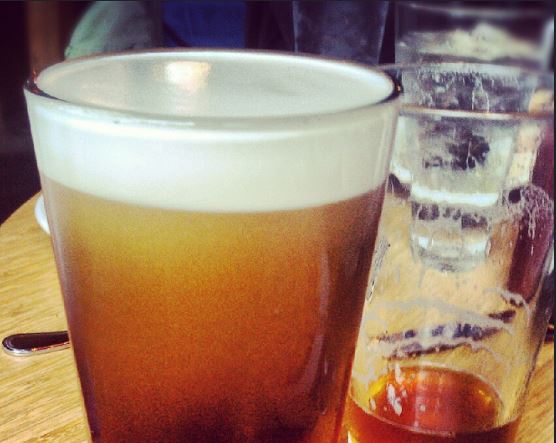Cold rain lashed the group gathered at the base of Ben Nevis, Scotland on October 18, 1883. As the highest peak in Scotland, Ben Nevis was selected as the location of Great Britain’s first high weather observatory, and the group planned a hike to the top for its dedication. Near the summit snow was piled over two feet deep, and blizzard-like conditions shortened the celebratory speeches. Without missing a beat the party simply moved inside. Scots expect weather of that nature, as a constant companion in life they simply make adjustments. It affects much of the custom of the country, including its beer.
In fortifying themselves against a harsh climate the Scots have been inescapably connected to beer. Historians acknowledge the Scottish have brewed since 6,500 BC or earlier, when the Picts were busy fermenting crude alcoholic beverages. Later their brew would become the stuff of legends, for instead of hops the Picts added the buds of Heather to their beer. Unfortunately, no written record of their brew survived and versions available today represent a best guess at the style. Not alone in that respect, the well known style of Scotch Ale also has clouded origins.
As in most of Europe, it was the church that constructed the first organized breweries. Missionaries arriving from Ireland in the 500’s AD contributed greatly to the nature of brewing in Scotland and solidified beer’s place in Scottish culture. Later, in the middle ages, home breweries appeared. Finally, in the 1500’s a growing population and economy justified the introduction of commercial breweries. Over the centuries the countless brewers of Scotland continued development of the rich, full, malty taste that dominated its beer market. Preferred through generations, it was popular well into the 1820s, when it fell from favor, displaced by the English style of Pale Ale.
Not surprisingly, it was the distinctive contrast of Pale Ale that captured beer drinkers attention. It was lighter in color, clear, clean and aggressively hopped. Despite the growing practice of adding hops to beer, Scottish styles remained malty. Not merely a matter of stubborn resistance, hops grew poorly in northern latitudes and as a scarce and expensive ingredient the Scots used hops sparingly. The malty brew of their ancestors must have looked tired in comparison to the new style and Scotch Ale’s popularity further waned. By the late 1800’s Pale Ale’s victory was so decisive that Scottish Ale effectively disappeared.
Most brewers love to recreate the old styles, but even the most dedicated and traditional struggle with Scotch ale. Problems with duplicating the old style arise in nearly every aspect of brewing. It begins with the malt. Kilning (drying) of malt in the bygone era was done with whatever fuel could cheaply heat the kiln. In Scotland it was peat, certainly it must have infused a smoky character into the beer. How much smoke permeated the malt? Hard to tell, and harder to measure. Problems continue past that obstacle. No records remain of the type of malt, its color, the variety of hops, or size of the brew. Worse yet, prior to the 18th century thermometers were absent from the brewhouse. Lack of temperature records leaves brewers with nothing but speculation on the mash and fermentation temperatures.
Knowledge of Scotch Ale that remained was gathered in bits and pieces. Generally it was defined by designators originally tied to the amount of malt used, and labeled by the amount of tax paid in shillings. Lower gravity brews were taxed as 60, 70 and 80 shilling ales and also go by the names light, heavy, and export. The title Scotch Ale (aka Wee Heavy) is reserved for those with higher alcohol levels, running from 90 up to 160 shillings. Assumptions based on old descriptions points to an original version of Ò90 shillingÓ ale with a gravity of up to 1.120 and a finish of 1.050, for a generous alcohol level approaching 9 per cent. Part of the residual sugars may have been contributed by kettle additions of brown sugar, and\or treacle. Today’s versions of Scotch Ale may be slightly lesser in stature, largely falling in an original gravity range of 1.070 to 1.130 and finishing with 5 to 8% alcohol.
Scotch Ales exhibit a profile with intrigue equal to the beer’s enigmatic past. Lighter examples cast a light amber\tawny tone which can deepen in more full variations through deep copper, to a dark reddish brown. Use of alcohol sensitive yeast strains renders only a partial fermentation of the malt, retaining the residual sugars that trademark Scotch Ale’s style. Full in body, the addition of high kilned malt in the grist offsets its sweet nature with a detectable roastiness. Carbonation, along with hop bitterness, flavor, and aroma all remain restrained in modern recreations, no doubt a faithful duplication of yesteryear’s Scottish brewing practices.
Complex and filling, the beer projects a light fruitiness with a blend of caramel, toffee, butterscotch, and roast. In better examples the flavors achieve a balanced union accented with a subtle hint of apple. Alcoholic warmth and a slowly building dryness mark the finish.
Try Scotch Ale on a quiet evening. Well suited as a sipping beer; settle in with one near an open hearth. Both the fire and Scotch Ale will align in a defense against the cold. Savoring the glass slowly yields a comfort that blots out the frigid, wind-lashed rains beating against the windows. With a little imagination you’re transported to the tiny weather observatory high atop Ben Nevis. Relax, the spartan stone walls fade into a comforting warmth. You’ll require nothing else; you have a Scotch Ale.
Reprinted courtesy of Gregg Smith

